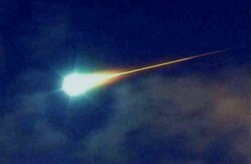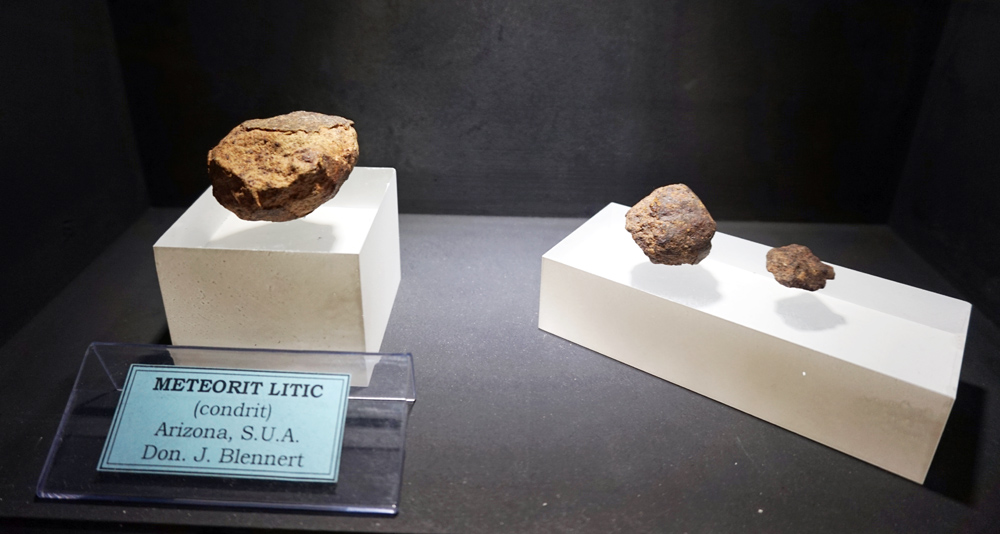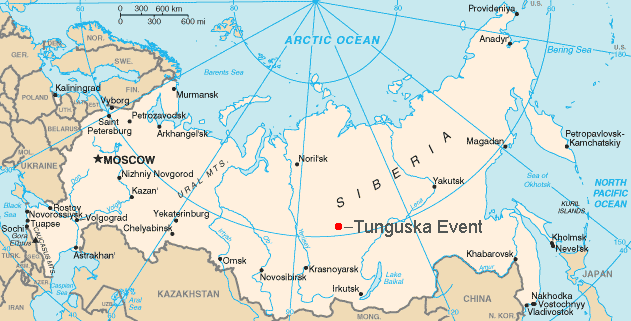|
Meteorite
A meteorite is a solid piece of debris from an object, such as a comet, asteroid, or meteoroid, that originates in outer space and survives its passage through the atmosphere to reach the surface of a planet or Natural satellite, moon. When the original object enters the atmosphere, various factors such as friction, pressure, and chemical interactions with the atmospheric gases cause it to heat up and radiate energy. It then becomes a meteor and forms a Meteoroid#Fireball, fireball, also known as a shooting star; astronomers call the brightest examples "Bolide#Astronomy, bolides". Once it settles on the larger body's surface, the meteor becomes a meteorite. Meteorites vary greatly in size. For geologists, a bolide is a meteorite large enough to create an impact crater. Meteorites that are recovered after being observed as they transit the atmosphere and Impact event, impact the Earth are called meteorite falls. All others are known as meteorite finds. Meteorites have traditiona ... [...More Info...] [...Related Items...] OR: [Wikipedia] [Google] [Baidu] |
Meteorite Falls
A meteorite fall, also called an observed fall, is a meteorite collected after its fall from outer space was observed by people or automated devices. Any other meteorite is called a "find". There are more than 1,100 documented falls listed in widely used databases, most of which have specimens in modern collections. , the Meteoritical Bulletin Database had 1211 confirmed falls. Importance Observed meteorite falls are important for several reasons. Material from observed falls has not been subjected to terrestrial weathering, making the find a better candidate for scientific study. Historically, observed falls were the most compelling evidence supporting the extraterrestrial origin of meteorites. Furthermore, observed fall discoveries are a better representative sample of the types of meteorites which fall to Earth. For example, iron meteorites take much longer to weather and are easier to identify as unusual objects, as compared to other types. This may explain the increas ... [...More Info...] [...Related Items...] OR: [Wikipedia] [Google] [Baidu] |
Iron Meteorite
Iron meteorites, also known as siderites, or ferrous meteorites, are a type of meteorite that consist overwhelmingly of an iron–nickel alloy known as meteoric iron that usually consists of two mineral phases: kamacite and taenite. Most iron meteorites originate from cores of planetesimals, with the exception of the IIE iron meteorite group The iron found in iron meteorites was one of the earliest sources of usable iron available to humans, due to the malleability and ductility of the meteoric iron, before the development of smelting that signaled the beginning of the Iron Age. Occurrence Although they are fairly rare compared to the stony meteorites, comprising only about 5.7% of witnessed falls, iron meteorites have historically been heavily over-represented in meteorite collections. This is due to several factors: * They are easily recognized as unusual even by laymen, as opposed to stony meteorites. Modern-day searches for meteorites in deserts and Antarctica yield a muc ... [...More Info...] [...Related Items...] OR: [Wikipedia] [Google] [Baidu] |
Micrometeorites
A micrometeorite is a micrometeoroid that has survived atmospheric entry, entry through the atmosphere of Earth, Earth's atmosphere. Usually found on Earth's surface, micrometeorites differ from meteorites in that they are smaller in size, more abundant, and different in composition. The International Astronomical Union, IAU officially defines meteorites as 30 micrometers to 1 meter; micrometeorites are the small end of the range (~submillimeter). They are a subset of cosmic dust, which also includes the smaller interplanetary dust particles (IDPs). Micrometeorites enter Earth's atmosphere at high velocity, velocities (at least 11 km/s) and undergo heating through drag (physics), atmospheric friction and Compression (physics), compression. Micrometeorites individually weigh between 10−9 and 10−4 g and collectively comprise most of the extraterrestrial material that has come to the present-day Earth. Fred Lawrence Whipple first coined the term "micro-meteorite" to des ... [...More Info...] [...Related Items...] OR: [Wikipedia] [Google] [Baidu] |
Meteorite Classification
In meteoritics, a meteorite classification system attempts to group similar meteorite, meteorites and allows scientists to communicate with a standardized terminology when discussing them. Meteorites are classified according to a variety of characteristics, especially mineralogy, mineralogical, petrology, petrological, chemistry, chemical, and isotope, isotopic properties. Terminology There is no single, standardized terminology used in meteorite classification; however, commonly used terms for categories include ''types'', ''classes'', ''clans'', ''groups'', and ''subgroups''. Some researchers hierarchize these terms, but there is no consensus as to which hierarchy is most appropriate. Meteorites that do not fit any known group (though they may fit somewhere within a higher level of classification) are ''ungrouped''. Genetic relationships Meteorite classification may indicate that a "genetic" relationship exists between similar meteorite specimens. Similarly classified meteorit ... [...More Info...] [...Related Items...] OR: [Wikipedia] [Google] [Baidu] |
Impact Event
An impact event is a collision between astronomical objects causing measurable effects. Impact events have physical consequences and have been found to regularly occur in planetary systems, though the most frequent involve asteroids, comets or meteoroids and have minimal effect. When large objects impact terrestrial planets such as the Earth, there can be significant physical and biospheric consequences, though atmospheres mitigate many surface impacts through atmospheric entry. Impact craters and Impact structure, structures are dominant landforms on many of the Solar System's solid objects and present the strongest empirical evidence for their frequency and scale. Impact events appear to have played a significant role in the Formation and evolution of the Solar System, evolution of the Solar System since its formation. Major impact events have significantly shaped History of the Earth, Earth's history, and have been implicated in the giant impact theory, formation of the Earth� ... [...More Info...] [...Related Items...] OR: [Wikipedia] [Google] [Baidu] |
Barringer Meteor Crater
Meteor Crater, or Barringer Crater, is a meteorite impact crater about east of Flagstaff and west of Winslow in the desert of northern Arizona, United States. The site had several earlier names, and fragments of the meteorite are officially called the Canyon Diablo Meteorite, after the adjacent Cañon Diablo. Because the United States Board on Geographic Names recognizes names of natural features derived from the nearest post office, the feature acquired the name of "Meteor Crater" from the nearby post office named Meteor. Meteor Crater lies at an elevation of above sea level. It is about in diameter, some deep, and is surrounded by a rim that rises above the surrounding plains. The center of the crater is filled with of rubble lying above crater bedrock. One of the interesting features of the crater is its squared-off outline, believed to be caused by existing regional jointing (cracks) in the strata at the impact site. Despite historic attempts to make the crater ... [...More Info...] [...Related Items...] OR: [Wikipedia] [Google] [Baidu] |
Meteor
A meteoroid () is a small rocky or metallic body in outer space. Meteoroids are defined as objects significantly smaller than asteroids, ranging in size from grains to objects up to a meter wide. Objects smaller than this are classified as micrometeoroids or space dust. Most are fragments from comets or asteroids, whereas others are collision impact debris ejected from bodies such as the Moon or Mars. When a meteoroid, comet, or asteroid enters Earth's atmosphere at a speed typically in excess of , aerodynamic heating of that object produces a streak of light, both from the glowing object and the trail of glowing particles that it leaves in its wake. This phenomenon is called a meteor or "shooting star". Meteors typically become visible when they are about 100 km above sea level. A series of many meteors appearing seconds or minutes apart and appearing to originate from the same fixed point in the sky is called a meteor shower. A meteorite is the remains of a meteoroid th ... [...More Info...] [...Related Items...] OR: [Wikipedia] [Google] [Baidu] |
Meteoroid
A meteoroid () is a small rocky or metallic body in outer space. Meteoroids are defined as objects significantly smaller than asteroids, ranging in size from grains to objects up to a meter wide. Objects smaller than this are classified as micrometeoroids or space dust. Most are fragments from comets or asteroids, whereas others are collision impact debris ejected from bodies such as the Moon or Mars. When a meteoroid, comet, or asteroid enters Earth's atmosphere at a speed typically in excess of , aerodynamic heating of that object produces a streak of light, both from the glowing object and the trail of glowing particles that it leaves in its wake. This phenomenon is called a meteor or "shooting star". Meteors typically become visible when they are about 100 km above sea level. A series of many meteors appearing seconds or minutes apart and appearing to originate from the same fixed point in the sky is called a meteor shower. A meteorite is the remains of a meteoroid th ... [...More Info...] [...Related Items...] OR: [Wikipedia] [Google] [Baidu] |
Meteoroid
A meteoroid () is a small rocky or metallic body in outer space. Meteoroids are defined as objects significantly smaller than asteroids, ranging in size from grains to objects up to a meter wide. Objects smaller than this are classified as micrometeoroids or space dust. Most are fragments from comets or asteroids, whereas others are collision impact debris ejected from bodies such as the Moon or Mars. When a meteoroid, comet, or asteroid enters Earth's atmosphere at a speed typically in excess of , aerodynamic heating of that object produces a streak of light, both from the glowing object and the trail of glowing particles that it leaves in its wake. This phenomenon is called a meteor or "shooting star". Meteors typically become visible when they are about 100 km above sea level. A series of many meteors appearing seconds or minutes apart and appearing to originate from the same fixed point in the sky is called a meteor shower. A meteorite is the remains of a meteoroid th ... [...More Info...] [...Related Items...] OR: [Wikipedia] [Google] [Baidu] |
Tunguska Event
The Tunguska event (occasionally also called the Tunguska incident) was an approximately 12-megaton explosion that occurred near the Podkamennaya Tunguska River in Yeniseysk Governorate (now Krasnoyarsk Krai), Russia, on the morning of June 30, 1908. The explosion over the sparsely populated Eastern Siberian Taiga flattened an estimated 80 million trees over an area of of forest, and eyewitness reports suggest that at least three people may have died in the event. The explosion is generally attributed to a meteor air burst: the atmospheric explosion of a stony asteroid about in size. The supposed asteroid approached from the east-southeast, and likely with a relatively high speed of about (~ Ma 80). It is classified as an impact event, even though no impact crater has been found; the object is thought to have disintegrated at an altitude of rather than having hit the surface of the Earth. The Tunguska event is the largest impact event on Earth in recorded history, thou ... [...More Info...] [...Related Items...] OR: [Wikipedia] [Google] [Baidu] |
Asteroid
An asteroid is a minor planet of the inner Solar System. Sizes and shapes of asteroids vary significantly, ranging from 1-meter rocks to a dwarf planet almost 1000 km in diameter; they are rocky, metallic or icy bodies with no atmosphere. Of the roughly one million known asteroids the greatest number are located between the orbits of Mars and Jupiter, approximately 2 to 4 AU from the Sun, in the main asteroid belt. Asteroids are generally classified to be of three types: C-type, M-type, and S-type. These were named after and are generally identified with carbonaceous, metallic, and silicaceous compositions, respectively. The size of asteroids varies greatly; the largest, Ceres, is almost across and qualifies as a dwarf planet. The total mass of all the asteroids combined is only 3% that of Earth's Moon. The majority of main belt asteroids follow slightly elliptical, stable orbits, revolving in the same direction as the Earth and taking from three to six years to comple ... [...More Info...] [...Related Items...] OR: [Wikipedia] [Google] [Baidu] |
Wabar Craters
The Wabar craters are impact craters located in Saudi Arabia first brought to the attention of Western scholars by British Arabist, explorer, writer and Colonial Office intelligence officer St John Philby, who discovered them while searching for the legendary city of Ubar in Arabia's Rub' al Khali ("Empty Quarter") in 1932. The expeditions 1932 Philby The vast desert wasteland of southern Saudi Arabia known as the Empty Quarter, or ''Rub' al Khali'' in Arabic, is one of the most desolate places on Earth. In 1932, Harry St John "Jack" Philby was hunting for a city named Ubar, that the Quran describes being destroyed by God for defying the Prophet Hud. Philby transliterated the name of the city as Wabar. Philby had heard of Bedouin legends of an area called ''Al Hadida'' ("place of iron" in Arabic) with ruins of ancient habitations, and also an area where a piece of iron the size of a camel had been found, and so organized an expedition to visit the site. After a month's jour ... [...More Info...] [...Related Items...] OR: [Wikipedia] [Google] [Baidu] |








